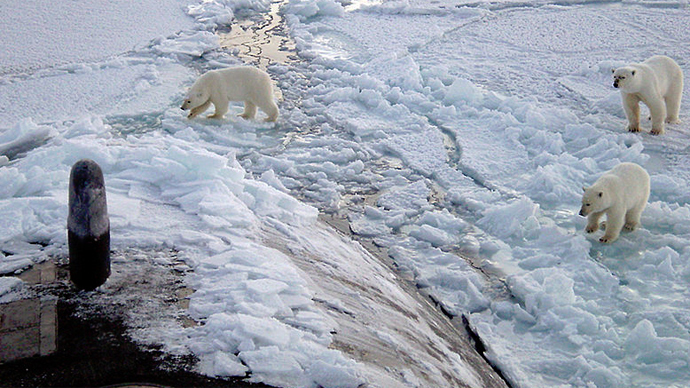US military set to increase presence in ‘melting’ Arctic

The US wants to be “very involved” in Arctic waters, as melting ice caps open opportunities for sea routes, US Defense Secretary Chuck Hagel has said. However, unlike other Arctic nations such as Russia, the Americans still lack the necessary hardware.
As the melting ice in the Arctic opens a new polar sea lane, the
issues of claiming and tapping energy resources, as well as
related security and environmental problems will continue to grow
in importance, Hagel told journalists en route to a security
conference in Halifax on Thursday.
“That’s going to give many new opportunities to countries, to
the world. That will come with new challenges as well. So the
United States needs to be very active in this group and be very
involved,” Hagel was quoted as saying by AP.
The US has been tempted by what it has estimated to be 13 percent
of the world’s undiscovered oil reserves and 30 percent of
undiscovered gas deposits in the Arctic. The areas with potential
resources have until recently been covered by an ice cap, which
is beginning to shrink.
According to experts quoted by AP, Arctic waters could see
largely ice-free summers as early as 2030, and there could be a
whole month of ice-free conditions by the mid-2020s. Ice-free is
understood to mean less than 10 percent coverage.
The prospect has prompted the US military to develop plans for
expanding communications, developing sturdy icebreakers, and
negotiating international agreements for tracking traffic in the
Arctic and conducting search-and-rescue operations. The US Navy
said it will complete the plans by the end of this year, with no
budget estimates currently available.

The director of the Navy’s task force on climate change, Rear
Adm. Jonathan White, said the US needs to step up its planning
efforts if it wants to operate ships and aircraft in the region
by 2025, as even the basic research and development plan has not
yet been outlined.
“What do I have to start thinking about now – about research,
planning, making long-term investments for things like hull
strengthening or bridge insulation, even how we conduct routine
operations like ship and aircraft refueling?” White
speculated, speaking at his office in the US Naval Observatory.
The US Coast Guard currently has just two working icebreaker
ships in service, and even those need to be fitted with hardened
hulls and better insulation if they are to operate in the icy
waters of the Arctic.
Security concerns should be foremost for the US and other nations
operating in the Arctic, White argued.
“We’re looking at a pretty dramatic increase in shipping, and
that brings into play the concern by the Arctic nations – how do
they respond to emergencies, search and rescue and people that
get into trouble up there,” he said.
The maritime traffic through the Bering Strait rose by about 50
percent between 2005 and 2012, with 483 ships moving through the
strait last year. Some of those vessels relied on the help of the
Russian ice breakers to travel across the so-called Northern Sea
Route.
Russia, which has been exploring the Arctic for centuries, is
still the only nation in the world operating a fleet of nuclear
icebreakers. The apparent advantages of nuclear ships for
operations in the Arctic include the absence of the need for
regular refueling – which currently is not an easy task in most
of the region.
Russian President Vladimir Putin recently stressed the Arctic was
essential for the country’s economic and security interests.

Speaking at the “Arctic – Territory Of Dialogue” forum in
September, Putin pledged to considerably increase the Arctic area
protected by the Russian government for its environmental
importance, and said about $44.5 million has been allocated for
cleaning up pollution already present in the region.
Putin stressed that the right to extract oil in the Arctic
“will only be given to operators, who have tried methods to
clean oil spills under ice.” The environmental activists
opposing any oil extraction in the region have, however, claimed
no reliable cleanup methods exist.
At the same time, the Russian President indicated the country has
been readying to defend its interests in the Arctic, beefing up
its military presence in the region for the worst-case scenario
by reviving former Soviet military bases there.
Other than Russia and the US, the nations that may lay their
claim on potential Arctic resources include Canada, Norway,
Finland, Iceland, Sweden and Denmark (through its territory of
Greenland). Those have been joined by China that sent its first
icebreaker ship through the Arctic last year and signed several
agreements with Arctic states.
President Barack Obama in May unveiled a 13-page US strategy for
the Arctic, asserting that nations must protect the region's
fragile environment and keep it free from conflict. However, the
plan also made it clear the US does not want to be left behind as
the other countries eye natural resources and exploiting
potential new sea routes.
The already existing North Sea Route, which lies in Russia’s
sector of the Arctic, has been experiencing a revival, and China
has shown interest in using it to reach European markets. The
route offers an alternative way from the Pacific to Europe, which
is shorter, faster and safe from pirates compared to the
traditional transit through the Indian Ocean and via the Suez
Canal to the Mediterranean. However, navigation in the Arctic
Ocean depends on the seasonal changes of ice coverage.














